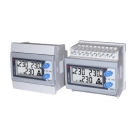Measuring to save

Metering is a valuable tool in the search for cost savings in commercial buildings, but it has to be applied the right way, says Alan Hickman of Carlo Gavazzi.
The drive for greater energy efficiency in our buildings continues to gather pace. A combination of regulation and rising prices has increasingly pushed the issue of energy use further up the business agenda.
As we know, the operational lifetime costs of buildings probably accounts for around 80% of expenditure. Of that 80%, building services make up by far the largest proportion. Therefore the ability to understand how that equipment is performing and how much energy it is using is very important.
Metering electrical services is an area the UK market has readily adopted. Installing meters can save 5 to 10% of the energy that is being metered. Savings can be significantly higher if meters identify unusual energy use — indicating, for example, equipment that has been left to run for unnecessarily long periods.
Good practice in metering electrical services can potentially save building owners thousands of pounds in unnecessary costs. But it is not just the benefit to the bottom line that has made metering such a key area for specifiers and building owners.
One of the biggest boosts for metering was Part L (2010) of the Building Regulations, which recognised the value of sub-metering in commercial buildings.
The most recent iteration of Part L2A (2013), which deals with new non-dwellings, states that ‘reasonable provision for energy meters would install energy metering systems that enable at least 90% of the estimated annual energy consumption of each fuel to be assigned to end-use categories’.
This means that it must be possible to measure how much energy different elements of building services such as heating or lighting use. Any renewable system should be separately monitored.
Also, buildings with a total useful floor area greater than 1000 m2 should have facilities for automatic meter reading and data collection.
Part L2B, which deals with works on existing buildings, recommends that metering provisions should be designed to ‘facilitate the benchmarking of energy performance as set out in TM46’ [CIBSE’s energy benchmarks].
The introduction of the Energy Savings Opportunities Scheme adds extra weight to Part L’s recommendations, with companies having 250 or more employees required to measure their energy use across their operations by December this year and then every four years hence.
Though there is no requirement for companies to act on the findings of these measurements, the scheme clearly opens the way for metering to play a major part in compliance with the scheme.
Furthermore, and importantly for installers, specifiers and manufacturers, the European Union’s Measuring Instruments Directive (MID) is designed to guarantee the accuracy and reliability of meters. Accuracy requirements for electricity meters are set out by the standard EN 62053-21 for Class 1 or EN50470-3 MID MI003 Class B.

This is particularly significant for building owners with multi-occupancy models where individual tenants are billed via sub-metering. Meters designed to be fully tamper-proof when correctly fitted with password protection and sealable or lockable covers are certified (Annex B+D, Annex B+F) for billing applications, giving consultants and installers a clear indication of the baseline for selecting their metering products.
With regulation clear on who needs to meter and the standards that must be met, the starting point for devising a metering strategy is to understand the key areas of consumption in a building; there is little point in metering low-consumption equipment where the savings potential is negligible. This means that the metering plan should incorporate all HVAC equipment, lighting, servers and computer terminals.
Once the key consumption areas are identified, the next step is to select a metering system that can gather the data in a way the building owner and operator can use to inform their energy strategy.
In the early days of metering, building owners metered to keep track of billing, with little analysis of the data being undertaken. Now there is a far greater awareness that the data gathered is a valuable asset. A metering system with software to analyse and track energy use within the building will provide intelligence on the running costs of a building and enable the user to more easily pinpoint savings opportunities.
This requires meters such as Carlo Gavazzi’s EM21, EM24 and EM23 that can communicate with the building energy management system (BEMS) through open-protocol networks to supply the metering information the BEMS requires to analyse energy-use patterns and identify anomalies of performance.
We are also about to launch the EM100 and EM300 series meters. These meters now have touchscreen technology and make standard user operations such as page scrolling, programming and parameter checks simpler and easier to read — avoiding any mechanical issues normally associated with using traditional keypads. Together with web-based monitoring systems, such as the VMU-C EM, VMU-Y EM and the EM2 Server, the EM100 and EM300 series represents a complete solution for energy management and multi-site installations.
Further measures, such as alarms to notify operators when consumption exceeds a certain level, help to provide intelligence on the running costs of a building that can lead to savings.
The days of metering simply to provide the energy company with a read-out from which to work out your next bill are over. Well-thought-out metering strategies have accelerated in the UK in recent years, and it is key that the metering technology meets the demands of building owners and operators.
Elegant solutions that can monitor, measure and converse with a BEMS ultimately, make an impact on those costs. They should be considered as much a part of a building’s design as the materials chosen to build it.
Alan Hickman is managing director of Carlo Gavazzi.







